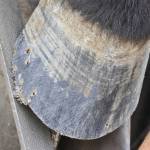Laminitis and Gene Expression in Horses

Laminitis involves a series of biochemical and cellular events that take place in the inner hoof tissues in horses that have had a triggering event such as ingesting an overload of carbohydrates. These events are not completely understood and are somewhat difficult to study because many of them occur before the horse shows evident signs of disease.
In a recent laminitis study, six clinically normal adult horses with no history or evidence of laminitis were used. The horses were divided into two groups, with control horses receiving no treatment. Trial horses were given oligofructose by nasogastric tube at the rate of 10 grams per kilogram of body weight.
After 24 to 30 hours, all horses in both groups were euthanized before any clinical signs of laminitis were evident. Samples of lamellar tissue were taken from each horse immediately after death and were preserved by freezing.
Gene expression between control and trial groups was analyzed, and results showed that 155 genes were upregulated and no genes were downregulated in the laminitis group. Among upregulated genes, the majority dealt with pro-inflammatory biochemical or cellular processes. Genes involved in protein degradation and turnover were also upregulated, as were some anti-inflammatory genes.
These changes in gene regulation preceded signs of pain or discomfort, development of vascular changes, separation of dermal-epidermal tissues, and inflammation in affected horses.
The authors of the research report suggested that at-risk horses could be given targeted anti-inflammatory therapy soon after the triggering event in hopes of preventing the development or halting the progression of laminitis.








